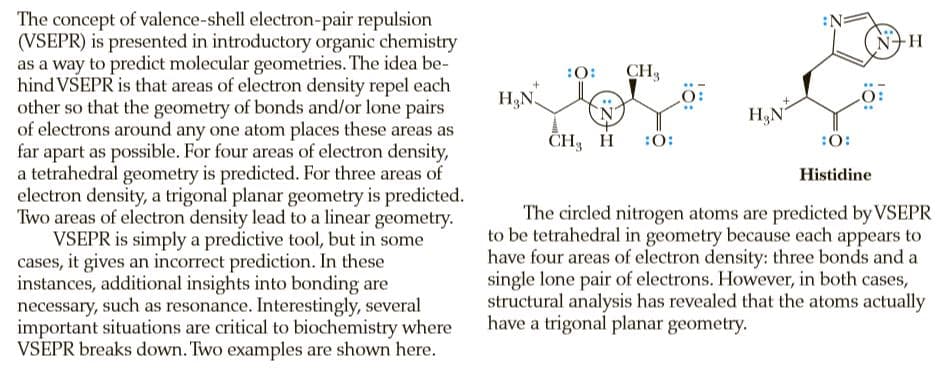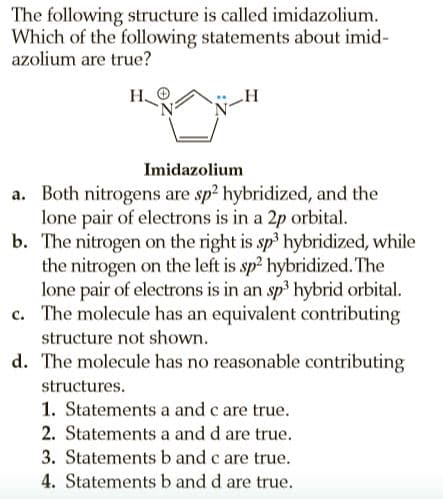The concept of valence-shell electron-pair repulsion (VSEPR) is presented in introductory organic chemistry as a way to predict molecular geometries. The idea be- hind VSEPR is that areas of electron density repel each other so that the geometry of bonds and/or lone pairs of electrons around any one atom places these areas as far apart as possible. For four areas of electron density, a tetrahedral geometry is predicted. For three areas of electron density, a trigonal planar geometry is predicted. Two areas of electron density lead to a linear geometry. VSEPR is simply a predictive tool, but in some cases, it gives an incorrect prediction. In these instances, additional insights into bonding are necessary, such as resonance. Interestingly, several important situations are critical to biochemistry where VSEPR breaks down. Two examples are shown here. :O: CH3 H,N H3N CH3 H :0: :0: Histidine The circled nitrogen atoms are predicted by VSEPR to be tetrahedral in geometry because each appears to have four areas of electron density: three bonds and a single lone pair of electrons. However, in both cases, structural analysis has revealed that the atoms actually have a trigonal planar geometry. The following structure is called imidazolium. Which of the following statements about imid- azolium are true? Н. Imidazolium a. Both nitrogens are sp2 hybridized, and the lone pair of electrons is in a 2p orbital. b. The nitrogen on the right is sp hybridized, while the nitrogen on the left is sp2 hybridized. The lone pair of electrons is in an sp3 hybrid orbital. c. The molecule has an equivalent contributing structure not shown. d. The molecule has no reasonable contributing structures. 1. Statements a and c are true. 2. Statements a and d are true. 3. Statements b and c are true. 4. Statements b and d are true.
The concept of valence-shell electron-pair repulsion (VSEPR) is presented in introductory organic chemistry as a way to predict molecular geometries. The idea be- hind VSEPR is that areas of electron density repel each other so that the geometry of bonds and/or lone pairs of electrons around any one atom places these areas as far apart as possible. For four areas of electron density, a tetrahedral geometry is predicted. For three areas of electron density, a trigonal planar geometry is predicted. Two areas of electron density lead to a linear geometry. VSEPR is simply a predictive tool, but in some cases, it gives an incorrect prediction. In these instances, additional insights into bonding are necessary, such as resonance. Interestingly, several important situations are critical to biochemistry where VSEPR breaks down. Two examples are shown here. :O: CH3 H,N H3N CH3 H :0: :0: Histidine The circled nitrogen atoms are predicted by VSEPR to be tetrahedral in geometry because each appears to have four areas of electron density: three bonds and a single lone pair of electrons. However, in both cases, structural analysis has revealed that the atoms actually have a trigonal planar geometry. The following structure is called imidazolium. Which of the following statements about imid- azolium are true? Н. Imidazolium a. Both nitrogens are sp2 hybridized, and the lone pair of electrons is in a 2p orbital. b. The nitrogen on the right is sp hybridized, while the nitrogen on the left is sp2 hybridized. The lone pair of electrons is in an sp3 hybrid orbital. c. The molecule has an equivalent contributing structure not shown. d. The molecule has no reasonable contributing structures. 1. Statements a and c are true. 2. Statements a and d are true. 3. Statements b and c are true. 4. Statements b and d are true.
Chemistry: Principles and Practice
3rd Edition
ISBN:9780534420123
Author:Daniel L. Reger, Scott R. Goode, David W. Ball, Edward Mercer
Publisher:Daniel L. Reger, Scott R. Goode, David W. Ball, Edward Mercer
Chapter10: Molecular Structure And Bonding Theories
Section: Chapter Questions
Problem 10.100QE: The molecular orbital diagram of NO shown in Figure 10.47 also applies to the following species....
Related questions
Question

Transcribed Image Text:The concept of valence-shell electron-pair repulsion
(VSEPR) is presented in introductory organic chemistry
as a way to predict molecular geometries. The idea be-
hind VSEPR is that areas of electron density repel each
other so that the geometry of bonds and/or lone pairs
of electrons around any one atom places these areas as
far apart as possible. For four areas of electron density,
a tetrahedral geometry is predicted. For three areas of
electron density, a trigonal planar geometry is predicted.
Two areas of electron density lead to a linear geometry.
VSEPR is simply a predictive tool, but in some
cases, it gives an incorrect prediction. In these
instances, additional insights into bonding are
necessary, such as resonance. Interestingly, several
important situations are critical to biochemistry where
VSEPR breaks down. Two examples are shown here.
:O:
CH3
H,N
H3N
CH3 H
:0:
:0:
Histidine
The circled nitrogen atoms are predicted by VSEPR
to be tetrahedral in geometry because each appears to
have four areas of electron density: three bonds and a
single lone pair of electrons. However, in both cases,
structural analysis has revealed that the atoms actually
have a trigonal planar geometry.

Transcribed Image Text:The following structure is called imidazolium.
Which of the following statements about imid-
azolium are true?
Н.
Imidazolium
a. Both nitrogens are sp2 hybridized, and the
lone pair of electrons is in a 2p orbital.
b. The nitrogen on the right is sp hybridized, while
the nitrogen on the left is sp2 hybridized. The
lone pair of electrons is in an sp3 hybrid orbital.
c. The molecule has an equivalent contributing
structure not shown.
d. The molecule has no reasonable contributing
structures.
1. Statements a and c are true.
2. Statements a and d are true.
3. Statements b and c are true.
4. Statements b and d are true.
Expert Solution
This question has been solved!
Explore an expertly crafted, step-by-step solution for a thorough understanding of key concepts.
This is a popular solution!
Trending now
This is a popular solution!
Step by step
Solved in 2 steps with 1 images

Recommended textbooks for you

Chemistry: Principles and Practice
Chemistry
ISBN:
9780534420123
Author:
Daniel L. Reger, Scott R. Goode, David W. Ball, Edward Mercer
Publisher:
Cengage Learning

Chemistry & Chemical Reactivity
Chemistry
ISBN:
9781337399074
Author:
John C. Kotz, Paul M. Treichel, John Townsend, David Treichel
Publisher:
Cengage Learning

Chemistry & Chemical Reactivity
Chemistry
ISBN:
9781133949640
Author:
John C. Kotz, Paul M. Treichel, John Townsend, David Treichel
Publisher:
Cengage Learning

Chemistry: Principles and Practice
Chemistry
ISBN:
9780534420123
Author:
Daniel L. Reger, Scott R. Goode, David W. Ball, Edward Mercer
Publisher:
Cengage Learning

Chemistry & Chemical Reactivity
Chemistry
ISBN:
9781337399074
Author:
John C. Kotz, Paul M. Treichel, John Townsend, David Treichel
Publisher:
Cengage Learning

Chemistry & Chemical Reactivity
Chemistry
ISBN:
9781133949640
Author:
John C. Kotz, Paul M. Treichel, John Townsend, David Treichel
Publisher:
Cengage Learning

Chemistry for Engineering Students
Chemistry
ISBN:
9781285199023
Author:
Lawrence S. Brown, Tom Holme
Publisher:
Cengage Learning

Principles of Modern Chemistry
Chemistry
ISBN:
9781305079113
Author:
David W. Oxtoby, H. Pat Gillis, Laurie J. Butler
Publisher:
Cengage Learning

Chemistry by OpenStax (2015-05-04)
Chemistry
ISBN:
9781938168390
Author:
Klaus Theopold, Richard H Langley, Paul Flowers, William R. Robinson, Mark Blaser
Publisher:
OpenStax